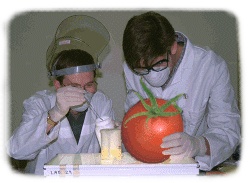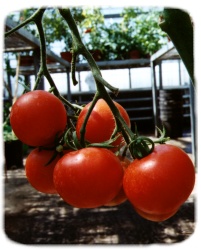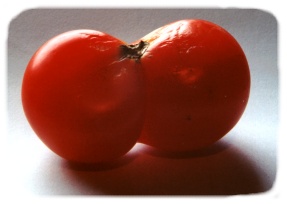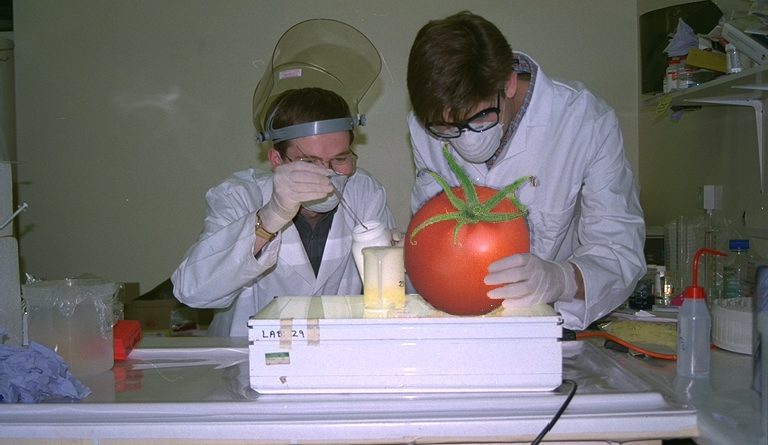Biotechnology and Tomato Fruit Ripening
 In 1990 I started a B.Sc. In Plant Biotechnology at Wye College, part of London University (but actually in rural Kent). I graduated in 1993, whereupon I started a PhD studentship at the University of Nottingham Department of Applied Biochemistry & Food Science, Sutton Bonington Campus. I graduated from Nottingham in the Summer of 1997.
In 1990 I started a B.Sc. In Plant Biotechnology at Wye College, part of London University (but actually in rural Kent). I graduated in 1993, whereupon I started a PhD studentship at the University of Nottingham Department of Applied Biochemistry & Food Science, Sutton Bonington Campus. I graduated from Nottingham in the Summer of 1997.
My Ph.D. work concerned the characterisation of Pectinesterase isoforms in tomato. The project was funded jointly by the Biotechnology & Biological Sciences Research Council and Zeneca Plant Science.
The enzyme Pectinesterase (EC 3.1.1.11) is found in all plants, and many plant pathogens. The enzyme is especially abundant in tomato, where it has been most extensively studied. In tomato, the enzyme has been detected in fruit, leaves and roots. In particular, the fruit contain very high levels of the enzyme, leading to the theory that it has an important role in fruit ripening and softening [1].
Column chromatography has been able to separate PE into distinct isoforms. The dominant isoform in tomato is called PE2. This isoform is fruit specific, and appears to increase during ripening. Most work on PE has concentrated on this isoform, due to the large amount of it in tomato fruit, and its ease of extraction. The enzyme has been purified, and genes coding for the enzyme have also been isolated. PE2 has been previously 100% downregulated in tomato using antisense inhibition [2]. Fruit from these downregulated plants still displayed some PE enzyme activity however, so it was thought that other isoforms unaffected by the antisense inhibition were active in the fruit.
The technique of antisense inhibition has now been used to “switch off” many genes in plants. The technique has been used to downregulate the gene corresponding to the main form of PE in tomato, PE2. These plants do not contain the PE2 enzyme, and have much reduced levels of PE activity compared to normal tomatoes. Fruit from the antisense tomatoes ripen normally, and the effect on softening of downregulating the PE2 enzyme is marginal. The small amount of PE activity present in the PE2 antisense fruit is due to the activity of other isoforms unaffected by the antisense gene. So far, there is good evidence for at least two minor isoforms of PE, PE1 and PE3. Unlike the main PE2 isoform, the other isoforms are not fruit specific. They may be important in cell wall biochemistry throughout the plant.
softening of downregulating the PE2 enzyme is marginal. The small amount of PE activity present in the PE2 antisense fruit is due to the activity of other isoforms unaffected by the antisense gene. So far, there is good evidence for at least two minor isoforms of PE, PE1 and PE3. Unlike the main PE2 isoform, the other isoforms are not fruit specific. They may be important in cell wall biochemistry throughout the plant.
Previous to my project, the PE isoforms were re-purified and the proteins sequenced at the N-terminal end. By screening a cDNA library with a degenerate probe designed from one of the N-terminal sequences, a cDNA clone encoding one of the two minor isoforms of PE was identified. Using a combination of both manual and automatic sequencing I have fully sequenced this cDNA [3], which has no sequence similarity to the major PE isoform previously isolated. It also has no sequence homology to PEs isolated from a range of other plant, fungal and bacterial species.
I have produced a construct in which a fragment of the novel PE cDNA was amplified using PCR, then cloned into a plant transformation vector. This vector was used to transform tomato plants in order to downregulate the isoform using antisense inhibition. I have screened the transformed plants using both PCR and Southern blotting to show the existence of the introduced cDNA fragment within the plants. To examine fruit from these plants for altered PE isoform profiles, a rapid method of separating the fruit PE isoforms using column chromatography, and a more efficient PE assay were developed. This procedure has given very good, reproducible separation of the isoforms. Unfortunately the isoform work has shown there to be no clear evidence that the enzyme has been downregulated. Northern blots have been able to detect the endogenous mRNA for the isoform, but not the artificially introduced antisense mRNA, so it is most likely that the chimeric cDNA is not being properly expressed.
the fruit PE isoforms using column chromatography, and a more efficient PE assay were developed. This procedure has given very good, reproducible separation of the isoforms. Unfortunately the isoform work has shown there to be no clear evidence that the enzyme has been downregulated. Northern blots have been able to detect the endogenous mRNA for the isoform, but not the artificially introduced antisense mRNA, so it is most likely that the chimeric cDNA is not being properly expressed.
Additionally, some of the enzymology developed as a part of this project is currently being used by other members of the cell wall research team at Nottingham. The work developed using tomato is being applied to enzyme extracted from other fruit (such as strawberry and mango) as it is eventually hoped to isolate and characterise PE genes from a range of fruit.
The ethics of using genetic engineering techniques for the improvement of food products are complex. What cannot be disputed is the immense value the techniques have in determining the role of individual enzymes in the complex processes of fruit ripening and softening.
[1] Tucker, G.A., Robertson, N.G. and Grierson, D. (1982) Purification and changes in activities of tomato pectinesterase isoenzymes. J. Sci. Food. Agric. 33: pp. 396-400.
[2] Hall, L.N., Tucker, G.A., Smith, C.J., Watson, C.F., Seymour, G.B., Bundick, Y., Boniwell, J.M., Fletcher, J.D., Ray, J.A., Schuch, W., Bird, C.R. and Grierson, D. (1993) Antisense inhibition of pectin esterase gene expression in transgenic tomatoes. Plant Journal 3: pp. 121-129.
[3] The sequence for this cDNA clone appears in the EMBL database as accession no. Z94058.
